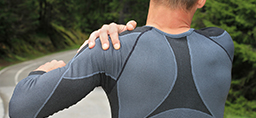
In a perfect world, of course, exercise injuries would never happen. We’d always take time to stretch, know when to say when and use perfect form.
But the reality is many people who work out—and almost everyone who works out intensely—is going to wind up with an injury eventually.
So Health Beat asked Spectrum Health sports medicine specialist Matthew Axtman, DO, to offer advice for preventing and treating some of the most typical injuries.
His first words of advice? Nip problems in the bud—exercising through pain is a bad idea.
“If something hurts, back down from activity for a few days, ice it and take an anti-inflammatory,” Dr. Axtman said, suggesting Advil. “But if it doesn’t go away in a few days, something feels a little amiss, or you can’t get back to your activities, come in and see a sports doctor. Something more significant is probably going on.”
Too often, he said, people think it’s better to suck it up and exercise through pain. “They’re afraid a doctor will say something like, `Stop running’ or `You can’t lift weights anymore.’”
Not true, he said.
“Doctors want to keep you moving,” Dr. Axtman said. “And often, there are things we can do—some bracing, for example, or a certain type of physical therapy that can fix the problem and save you years of pain.”
Dr. Axtman, a specialist in non-surgical orthopedics and sports medicine, breaks down the issues he most often sees.
4 common exercise injuries:
1. Runner’s knee, or femoral pain syndrome
Cause: Repetitive motion from walking or running causes irritation in the cartilage under the knee. It’s so common it accounts for as much as 25% of all running injuries. Women are especially vulnerable.
Treatment: Addressing muscle imbalances by strengthening hip, glute and quad muscles.
2. Hip pain
Cause: While there are many potential sources of hip pain, Dr. Axtman said one of the most common is one-sport exercisers. “We see this most often, for example, in runners who just don’t want to do anything but run.”
Treatment: Varying workouts, including introducing disciplines like yoga and Pilates. Strengthening muscles in hips, legs and lower back and stretching before workouts also help.
3. Shoulder woes
Cause: Shoulders, one of the largest and most complex joints in the body, are among the most frequently injured. They’re prone to arthritis, tendonitis and rotator cuff injuries. Dr. Axtman said it’s especially common for people trying to build strength to overload the joint.
Treatment: Physical therapy can help, offering a routine of gentle stretches, to keep muscles long, and strength-training. “Working out with a trainer who can observe technique can also have a big impact,” he said. “Often people aren’t aware that they’re doing too much, moving too fast or that their form is wrong.”
4. Plantar fasciitis
Cause: This sharp heel pain happens when the fascia, the thick band of tissue that runs along the bottom of your feet, gets inflamed. It’s most common among people with high-impact sports that involve running and cutting, such as soccer and basketball. And it’s usually most intense in the morning.
Treatment: Ice and more supportive shoes can provide short-term relief, while an at-home stretching regimen eventually eliminates the pain.
Whatever aches, the sooner professionals can get a handle on it, the better. “Don’t wait until it turns into something that’s going to take longer to heal up or need more aggressive treatment,” Dr. Axtman said. “Our goal is to keep you as active—and pain-free—as possible.”
 /a>
/a>
 /a>
/a>
 /a>
/a>